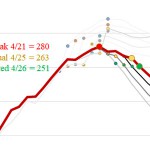The Difficult Math of COVID Death
Roger Kimball’s place in the arena of public comment has expressing the hard line of the conservative view with calm wit and erudition. When it comes to our nation’s response to COVID-19 and the question of reopening our economy, I can’t help but contrast his voice with the hysteria I’ve witnessed in response to those of us who’ve tried to suggest some additional weight be put on the scale for opening up:
One original goal of the flood-the-zone response to the coronavirus was to determine the real lethality of this new bug. But this brings us back to the Santa Clara study. The number that matters is not the percentage of those who get sick and then die but rather the number of those who have been exposed to the virus.
Case fatality rate is the chance someone will die after testing positive for a disease. In many studies, the case fatality rate has fallen from 3–4% to around 1%. However, the CFR is not what we think of intuitively as the true mortality of the disease. The true mortality rate, or infection fatality rate (IFR), is the proportion of those who died of the disease among those who were infected, whether or not they were tested.
To put this in perspective, consider the seasonal flu. “The CDC states,” Geach notes, “that 247,785 people tested positive for the flu this winter and about 24,000 died. This makes the CFR for the flu 10%; nine in ten people who get the flu don’t die of it! While only 247,785 people tested positive, the CDC estimates that 39 million people were actually infected with influenza this winter. Hence, the IFR for the flu is around 0.1%.” [Emphasis in the original.]
I do think Kimball could put a little bit more emphasis on how justifiably terrified certain populations are of this disease, but as adults in a self-governing society, we have to be able to assess these matters with some emotional distance. “How many people are you willing to see die” is an uncomfortable question to answer, but it can’t be the final word. People die. It can’t be stopped. And the response our leaders have chosen to this disease will also cause death, although how much nobody has attempted to quantify.
Moreover, that unfair question is not the only one we can ask. How many children are the lockdown advocates willing to see starve? How many people are they willing to condemn to a living hell of loneliness and depression? And so on. There is no formula into which we can plug human society and come up with the right answer.
The reasonable answer to the mortality question is this: as few as possible. Choose a clear measure, like hospitalizations. Determine a ceiling for that metric, such as the number of hospital beds available. Track the numbers and estimate trends as accurately as possible, and that’s the guide. In the meantime, craft a strategy for protecting the people who are most threatened by the disease.
Rhode Island’s government is only now implementing a “strike force” to help nursing homes with staffing challenges. This should have been a core component of our response to the disease from the beginning.
The U.S. Census estimates that an average of around 27 people die in Rhode Island each day. Over the 55 days since the first COVID-19 diagnosis, that would equal 1,477 people. The 202 deaths attributed to the coronavirus represent just under a 14% increase. That is a terrible reality, but how much wouldn’t be? A majority of those deaths resulted from outbreaks in nursing homes. The narrow nature of that threat makes it more manageable, meaning there are other ways than social closure to keep the numbers down.
Meanwhile, we can expect to learn that this period of time is seeing a significant increase in deaths of despair, in one form or another. Kimball cites a total of 10,000 “economic suicides” attributable to the 2008 recession. Even now, Governor Raimondo’s announcements indicate that we’re seeing a surge in domestic violence.
How much of that are we willing to tolerate? As the questions accumulate we begin to see the allure of handing responsibility for answers off to some government official, so we can stomp our feet and insist, “None!” I share Kimball’s hope that we’ll start seeing proof that our society is more mature than that.




